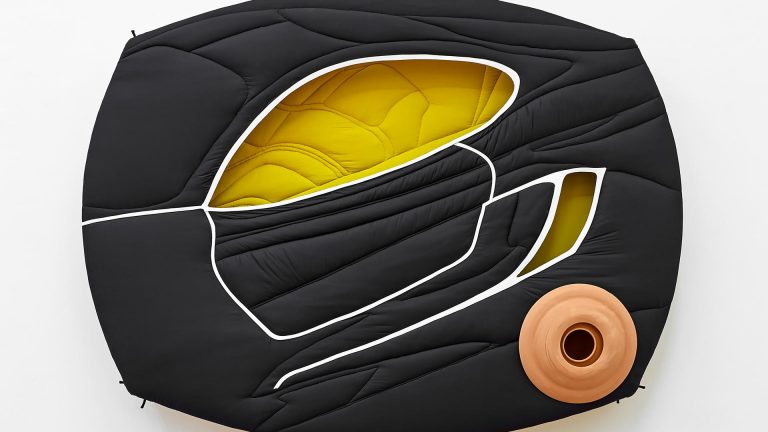Artists: EJTECH (Esteban de la Torre and Judit Eszter Kárpáti)
Exhibition title: Phase In, Phase Out
Venue: Horizont Gallery, Budapest, Hungary
Date: December 5, 2018 – January 16, 2019
Photography: Dávid Biró, all images copyright and courtesy of the artists and Horizont Gallery, Budapest
Sound as an informational source is described in terms of auditory attributes, such as timbre, tone, pitch, duration, loudness. These characteristics are analyzed and give relevance to the delivery of musical meaning. But sound is not only about deduced meaning. It is about physical energy shared. Sound as a vibrational force links humans bodies and matter at a material level, via physical resonation. Human beings perceive sound, either when it is heard by entering the ear canal or when corporeally experienced. It is on and in our body that acoustic waves become discernible.
Phase In, Phase Out is the result of an art-based study on the crossmodal, employing sound, textile and space as one unified medium. By augmenting textile into a multi channel electroacoustic transducer, EJTECH explores the “alogogenic” properties of sound via the unique timbre of textile, through sound pieces or “electronic poems” specifically written for, and performed on a purely textile-sound system. Patterns of high, mid and low range frequency tones sweep across the textile pieces, creating sound and resonating in the physical space. Phase In, Phase Out deals with the audio-physical experience of space and matter which are determined in form and content by controlled movements of the textile. The raw manifestation of sound, and its vibrational force amount to a polysensorial experience and an exercise in liminality.
EJTECH is Esteban de la Torre and Judit Eszter Kárpáti. A polydisciplinary studio based in Budapest, Hungary, working with unstable media, alternative interfaces, electronic textiles and future materials, focusing their artistic research on the cross modal synergy between the physical and digital, the process of sensory integration and further explorations on human-computer interaction via interactive installations and dynamic art pieces. Haptic audio-visual alchemy, and techno-spiritualism.
Text by Bálint Veres PhD, associate professor of MOME
The work consists of three elements: one stands, one lies and one hangs. Blue, black and white with plastic, spatial and visual qualities. Creating a hybrid of soft, rigid, and immaterial structures, in a random, but highly calculated spatial arrangement. Direct and indirect lighting, with exposed surfaces, adumbral sides and hidden faces.
The three elements coincide with visible and invisible context systems: technical devices that feed the components through non-cut umbilical cords; information packets circulating between the devices and the channels between the objects; as well as the ephemeral sounding phenomena that emerge from these technology systems, which encompass the full spectrum of noise, plastic sound and music.
In the three elements of the installation of EJTECH, as we enter into this strong acoustical, semi-illuminated space, we can easily recognize the archetypical requisites of spiritual traditions: the totem, the tabernacle, or the axis mundi, whose vocation is to refer to transcendence in immanence. The altar, the instrument of celebration of the rite, a sounding and vibrating textile surface that has simultaneously conjured magical associations (flying carpet) and sacrificial imagery (the memories of silent fishes before sacrifice). Finally there is the icon or iconostasis, which is also a sanctuary, with its whiteness is the marker of illumination that is no longer visible to the eye.
The main motif, that is certainly the first to appear in our eyes, is the spiral form, the visual and technological spiritus of the work. The spiral-shaped electromagnetic coils are means of sound generation with electromagnetic induction. The spiral, an archaic spiritual symbol, a symbol of faith in the center and a map of inner life practices.



























